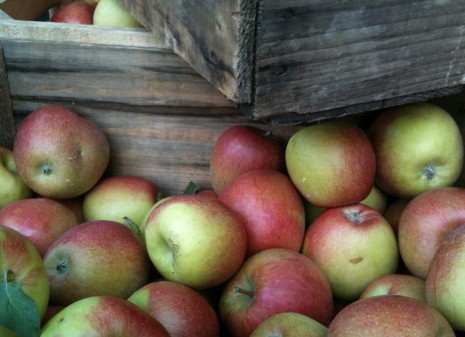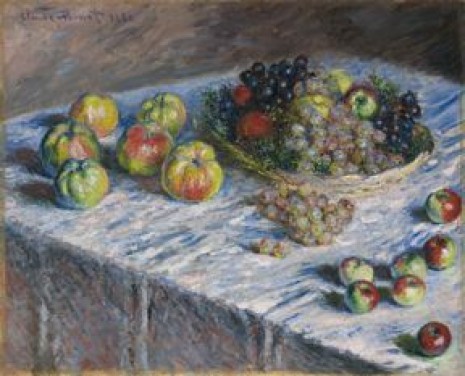APPLES: SHOPPING, COOKING, & EATING GUIDE
A visit to any farmers market this time of year will tell you that there are more apple varieties to choose from than ever before. You’ll find crates of rough-skinned heirloom russets plunked down next to more conventionally handsome Gala, Fuji, and Honeycrisp. Which are best for eating out of hand? For baking or applesauce?
All is revealed below, along with brief (i.e., far-from-comprehensive) descriptions of the apples I’m seeing around town this year. Bear in mind that, depending on the grower and his or her location, any variety can have an off-year due to weather, be picked too early (and thus be starchy or lack flavor development), or, later in the winter, be poorly handled once out of cold storage. Storage, by the way, isn’t a bad thing; some varieties are traditionally stored for a time to allow starch to convert to sugar or to mellow acidity. Sample apples from different growers and buy what tastes good to you. And because some varieties are more thin-skinned (and more easily bruised) than others, be gentle when selecting what you want as a courtesy to the seller and fellow customers. At home, keep apples in the refrigerator to delay ripening; if left out at room temperature, they’ll overripen and turn mealy. Larger apples ripen faster than small ones do.
A quick recipe note: When fried—that is, simply sliced and sautéed in butter—apples are a component of many a scratch supper in this household. I get them working in a small skillet on a back burner just as I’m pulling everything else together. By the time they’re browned and a little crisp on the outside, they’re creamy inside. They make a fabulous side to pork chops, ham, sausages, or roast chicken.
Crisp, Flavorful Apples for Eating Out of Hand Ashmead’s Kernel, Braeburn, Calville Blanc D’Hiver, Empire, Fuji, Honeycrisp, Jonagold, Macoun, Northern Spy, Winesap
Apples That Resist Browning (for Salads) Calville Blanc, Cortland, Granny Smith
Firm Apples for Pies and Fry-Ups Cortland, Granny Smith, Jonagold, Ida Red, Northern Spy
Apples for Baking Whole Cortland, Fuji, Jonathan, Ida Red, Mutsu, Rome, Winesap
Apples for Sauce Braeburn, Gala, Ida Red, Jonathan, Macoun, McIntosh, Mutsu, Winesap; mix two or three varieties for complexity of flavor
Cheat Sheet to Apple Varieties*
Ashmead’s Kernel: A classic example of the russet type, this 300-year-old variety is distinguished by its bronzed skin, rich sweetness, and juiciness.
Braeburn: A 1952 New Zealand apple with an intoxicating cidery aroma and great sweet-tart balance.
Calville Blanc D’Hiver: Cultivated in France since the 16th century, this great dessert apple of the world has tender, spicy flesh (the flavor improves in storage). Also notable for its ribbed appearance (well, at least Claude Monet thought so; see photo below) and the fact that it contains more vitamin C than an orange.
Cortland: This New York State McIntosh cross, introduced in 1898, is crisp, juicy, and more tart than sweet.
Empire: The year 1966 gave us the first episode of Star Trek, the Ford Mustang Fastback, and this sweet, slurpy, satisfyingly crunchy Red Delicious–McIntosh cross from New York State.
Fuji: Although the Fuji wasn’t introduced from Japan into the U.S. until the 1980s, its distinguished American pedigree includes the Ralls Janet (named in 1793 by Thomas Jefferson). Great flavor and texture; excellent keeper.
Gala: David O. Selznick would have loved this New Zealand apple for its Technicolor yellow skin dusted with red. Small, crisp, mild, and a good keeper, it’s ideal for lunch boxes and brown bags.
Golden Delicious: This West Virginia apple (dating from around 1914 and unrelated to Red Delicious) is aromatic and sweet. When shopping, look for apples pale yellow in color. If chartreuse, the fruit has been harvested too early; if deep yellow, you can bet the flesh will be overripe. Not a good keeper.
Golden Russet: If you find cider made from this mid-19th-century New York cultivar, pounce.
Granny Smith: An Australian apple dating from 1868, the Granny Smith is a fine, if not especially complex, tart (not sour) cooking apple. Although it remains green when ripe, paler specimens usually have more sweetness than those that are bright-green.
Honeycrisp: Released in 1991, this wildly popular Macoun cross from Minnesota has a wonderful snap and a mellow, honeyed flavor.
Ida Red: This tart 1942 Jonathan cross from Idaho adds character to pies, but it’s never been known as an eating apple. Perhaps the thick skin, which is a femme-fatale deep red, is a bit of a turn-off. Unpeeled Idas cook down into a pretty applesauce or apple butter, though; just strain the peels out at the end.
Jonagold: The fact that this 1968 Jonathan cross from New York is a bigger seller in Europe than it is at home is a mystery. Juicy, crunchy, and flavorful, it’s a terrific all-around eating and cooking apple.
Jonathan: This New York apple, which dates from around 1826, has a complex flavor, but it doesn’t keep well. Buy it when you see it and don’t let it linger too long in the fridge.
Macoun: A 1923 New York variety (pronounced ma-KOON**) that’s juicy and aromatic, with richer flavor than its parent McIntosh.
McIntosh: From Ontario (1798), this apple is a proud parent of Cortland, Empire, and Macoun. Its flesh breaks down quickly, which is why it’s so handy for applesauce. Because it’s not a good keeper, enjoy it while you can.
Mutsu (often labeled Crispin): This crisp, delicately spicy cultivar (pronounced moot-tsoo) is a Golden Delicious cross developed in Japan and introduced to the U.S. in the late 1940s. When shopping, look for specimens with a decidedly yellow background color. A greenish undertone is a sign of a too-early harvest, and you won’t get the best flavor.
Newtown Pippin: Tart and richly flavored, this Long Island cultivar, from the 1700s, is one of the world’s great keeping apples; its flavor gets fuller and sweeter after being stored. Compared with Granny Smith in a tasting, you’ll discover that the Newtown has more complexity. Unlike Granny Smith, though, it browns soon after being sliced.
Northern Spy: If you grew up in the East, this is the apple your grandmother used for pies. Originating in New York around 1800, it’s sweet-tart, juicy, and high in vitamin C.
Red Delicious: Bred for its beauty-pageant appearance and ability to endure long-distance shipping, this is the bestselling apple in the U.S. and a testament to—oh, don’t get me started. At its best, it’s on the tart side, but more often it’s insipid beyond belief; cooked, it disintegrates to mush.
Rome (or Rome Beauty): Named for Rome Township, Ohio, where the first large, thick-skinned fruit appeared back in the 1820s, this is the quintessential apple for baking whole.
Winesap: An all-around great kitchen apple, with a potent winey, spicy fragrance and flavor. First cultivated in New Jersey, it was important to the cidermaking industry by 1817. Today, it’s often eclipsed (and confused with) its sweeter offspring Stayman Winesap.
*Among the purveyors at the Union Square Greenmarket, Terhune Orchards (Salt Point, New York) is always reliable and they treat their apples with great care. For a range of heirloom varieties, try Samascott Orchards (from Kinderhook, New York). For market-day information, click here.
** The tomato-tomahto folks pale in comparison to the eminent authorities who disagree about the pronunciation of the word Macoun. The apple—developed at the New York State Agriculture Experiment Station in Geneva, New York, and named for the Canadian horticulturalist W.T. Macoun—may be called “mah-COW-an,” “mah-COWN,” or “mah-KOON.” The first pronunciation is correct as per Geneva, but the last is far more common. I’ve gotten so tired of being corrected, I’ve given up and added this to my list of Battles I Choose Not to Fight.
Posted: November 29th, 2011 under autumn, baking, cooking, Union Square Greenmarket.
Comments
Comment from admin
Time December 1, 2011 at 1:47 pm
Dear Leslie,
Thanks so much! Delighted you enjoyed it.
Cheers,
Jane
Comment from Malcolm Lawson
Time December 17, 2011 at 7:08 pm
Thanks for a great apple cheat sheet Jane.
I have been trying to perfect my Tarte Tatin. Tried Granny Smith with total disaster – a complete Julia :^) ended up with a pastry base and apple sauce. I recently tried a combo tarte with Gala, Jonathan and Rome. Jonathan held up best followed by Rome. Gala was too soft. Best flavour was Rome.
BTW, Best pastry is from Rachel Allen made with sour cream and a little calvados. Caramel is from Jamie O again using calvados.
Take care to boil off excess water after adding apples to the pan.
Still a work in progress.
Malcolm
Comment from tamara
Time December 1, 2013 at 5:00 pm
I made SK’s apple slab pie. The first time I didn’t pay attention to the apples used and it turned out perfect. Great consistency and the bottom crust was cooked and held up even after several days. Next time I made it I used braeburns and it was a liquid mess!! What apple(s) do you recommend for a flat slab pie? because I love the recipe and want to do it again but I don’t want a liquid mess and soggy bottom crust. thanks!!!
Pingback from Apple Slab Pie | cluttercafe
Time July 8, 2015 at 6:56 pm
[…] out Jane Lear’s Apple Guide for information on best apples to […]




Comment from Leslie Macchiarella
Time December 1, 2011 at 10:01 am
Wow Jane! What an awesome accounting of the apple world. Nice resource! Thanks!